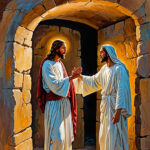Constantine I, also known as Constantine the Great, left an indelible mark on history through his conversion to Christianity and the subsequent Christianization of the Roman Empire. Born in 272 CE, Constantine rose to power during a tumultuous period marked by civil wars, economic challenges, and political instability. His vision at the Battle of the Milvian Bridge in 312 CE played a pivotal role in shaping the course of Christianity within the empire.
The Crisis of the Third Century
Before Constantine’s rise, the Roman Empire grappled with multiple crises. Droughts, famines, plagues, and inflation plagued the land. Generals vied for control, leading to civil wars and a succession of short-lived emperors. In 306 CE, Constantine’s father, Flavius Constantius, became one of the Caesars of the Western Roman Empire. When Emperor Diocletian retired, the empire was divided into East and West, with co-emperors and appointed Caesars and Augusti.

The Vision at the Milvian Bridge
Constantine’s path to sole rulership was fraught with challenges. His opponent in the West was Maxentius, and their armies clashed near the Milvian Bridge in Rome. The night before the decisive battle, Constantine prayed for success. In a vision or dream, he saw an image bearing the words “In Hoc Signo Vinces” (“In this sign, conquer”). The exact nature of the symbol remains debated, with sources attributing it either to the sign of the cross or the superimposed letters chi and rho (the first two letters of ‘Christ’ in Greek).
Lactantius, a Latin historian of North African descent who was rescued from poverty by Emperor Constantine the Great and appointed as the tutor to his son Crispus, gives us a firsthand account. In a dream, Constantine was commanded to adorn his soldiers’ shields with a “heavenly divine symbol” (Latin: coeleste signum dei). The exact symbol selected by Constantine, as described by Lactantius, is ambiguous but appears to be akin to a Tau-Rho or a staurogram, both early Christian symbols. On the same day, Constantine’s forces engaged and defeated Maxentius at the Battle of the Milvian Bridge in 312, just outside of Rome.

The Chi Rho (☧) is a venerable Christian symbol created by overlaying the first two Greek letters of “Christ” (ΧΡΙΣΤΟΣ). The rho’s vertical line intersects the chi’s center. It was used by early Christians to signify Jesus Christ and Christianity. Emperor Constantine the Great incorporated the Chi Rho into the Labarum, a military standard, which was instrumental in his triumph at the Battle of the Milvian Bridge in 312 AD. The Chi Rho continues to be a potent symbol of Christian faith and identity today.
Victory and Conversion
Constantine emerged victorious at the Milvian Bridge, and he attributed his success to the Christian God. This pivotal moment led to significant developments:
- Edict of Milan (313 CE): Constantine, along with Licinius, issued the Edict of Milan, granting religious freedom throughout the empire. This edict specifically ended the persecution of Christians, allowing them to practice their faith openly.
- Christianization of the Empire: Constantine’s conversion marked a turning point. He actively supported Christianity, convening the First Council of Nicaea in 325 CE. This council addressed theological disputes and laid the groundwork for Christian doctrine. Constantine also promoted Christian practices within the empire, leading to the construction of churches and the adoption of Christian symbols.
- The Chi-Rho Symbol: Constantine’s vision at the Battle of the Milvian Bridge, where he saw the words “In Hoc Signo Vinces” (“In this sign, conquer”), played a pivotal role. The exact nature of the symbol remains debated, but it is often associated with the superimposed letters chi (Χ) and rho (Ρ), representing the first two letters of “Christ” in Greek. This symbol became a powerful emblem of Christian identity.

Legacy
Constantine’s embrace of Christianity laid the groundwork for its eventual dominance in the Roman Empire. His vision not only secured his rule but also transformed the religious landscape, leaving an indelible mark on Western civilization.













